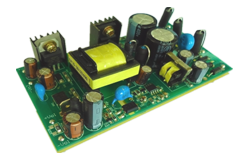বাতৰি
Designing an Industrial AC-DC Converter
Author: ZYG Power Module Time: 2023-5-7
Introduction
An AC-DC converter is an essential component in industrial power systems. It is used to convert the alternating current (AC) power from the grid into the direct current (DC) power that is required by various industrial devices. The design of an AC-DC converter is critical because it affects the efficiency, reliability, and performance of the entire power system. In this article, we will discuss the key factors to consider when designing an industrial AC-DC converter.
Input Circuit
The input circuit of an AC-DC converter is responsible for rectifying the AC power from the grid into DC power. The most common type of input circuit is the full-wave rectifier, which consists of four diodes arranged in a bridge configuration. When the AC voltage is positive, two diodes conduct current, and when the AC voltage is negative, the other two diodes conduct current. This results in a DC voltage that is the average of the AC voltage.
Filter Circuit
The filter circuit of an AC-DC converter is responsible for smoothing out the pulsed DC voltage from the input circuit. The simplest type of filter circuit is the capacitor filter, which consists of a capacitor connected in parallel with the load. The capacitor stores charge during the on-time of the rectifier and releases it during the off-time, resulting in a smoother DC voltage. The size of the capacitor depends on the load current and the ripple voltage allowed.

Output Circuit
The output circuit of an AC-DC converter is responsible for regulating the DC voltage to the desired level. The most common type of output circuit is the voltage regulator, which maintains a constant output voltage despite changes in the input voltage or load current. There are two types of voltage regulators: linear and switching. Linear voltage regulators are simple and reliable but are inefficient and generate a lot of heat. Switching voltage regulators are more complex but are highly efficient and generate less heat.
Protection Circuit
The protection circuit of an AC-DC converter is responsible for protecting the converter and the load from overvoltage, overcurrent, and overheating. The most common type of protection circuit is the fuse, which cuts off the current flow when the current exceeds a certain limit. Other types of protection circuits include overvoltage protection devices, overcurrent protection devices, and thermal protection devices.
Conclusion
Designing an industrial AC-DC converter requires careful consideration of the input circuit, filter circuit, output circuit, and protection circuit. The choice of components and their specifications affect the efficiency, reliability, and performance of the converter. A well-designed AC-DC converter can provide stable and reliable power to industrial devices, which is critical for the smooth operation of industrial processes.
পূৰ্ৱবৰ্তী: AC-DC Power Supply: The Ultimate Solution for Reliable Energy Conversion
এটাৰ পাচৰ: AC-DC Power Supply: The Ultimate Solution for Reliable and Efficient Power Conversion
প্ৰাসংগিক তথ্য
-
2023-7-17
Exploring the World of Medical Power: A Comprehensive Series
Introduction: The medical field is a vast and ever-evolving realm that holds immense power to heal, cure, and improve the lives of individuals. In this comprehensive series, we will delve into various facets of medical power, exploring its different dimensions, advancements, and the impact it has on society. From groundbreaking medical technologies to the ethical dilemmas faced by healthcare professionals, this series aims to shed light on the multifaceted world of medical power. Chapter 1: The Evolution of Medical Power: In this chapter, we will trace the origins of medical power and its evolution over time. From ancient healing practices to the advent of modern medicine, the journey of medical power has been marked by significant milestones. We will explore...
সবিশেষ চাওক -
2023-5-12
AC-DC Power Supply: Providing Efficient and Reliable Power Conversion
An AC-DC power supply is an essential component in many electronic devices and systems. It is responsible for converting alternating current (AC) power from the mains into direct current (DC) power that can be used by electronic circuits and devices. This process of conversion is crucial for ensuring the efficient and reliable operation of a wide range of electronics, from small household appliances to large industrial machines. One of the key advantages of an AC-DC power supply is its ability to provide a stable and regulated output voltage. This is important because electronic circuits often require a specific voltage level in order to function correctly. If the voltage is too low or too high, it can cause components to malfunction...
সবিশেষ চাওক -
2023-4-20
How to Build a 120 Volt AC Power Supply for 3 Volt DC Output
If you looking to power a small device that requires 3 volts of DC power, you may be wondering how to build a suitable power supply. One option is to build your own 120 volt AC power supply and use a voltage regulator to step down the voltage to 3 volts. Here how to do it: Materials: - Step-down transformer (120V AC to 12V AC) - Bridge rectifier - Capacitor - Voltage regulator (LM317) - Heat sink - Resistors - Potentiometer - LED - 3 volt DC load - Soldering iron and solder - Multimeter Step 1: Choose a transformer The first step is to choose a step-down transformer that converts the 120V AC input to 12V AC output. Make...
সবিশেষ চাওক -
2023-4-25
AC-DC Power Supply: Efficient and Reliable Energy Conversion Solution
An AC-DC power supply is an efficient and reliable solution for energy conversion in various applications. It is a device that converts alternating current (AC) into direct current (DC) by rectifying and smoothing the AC waveform. The output of an AC-DC power supply can be regulated or unregulated depending on the application requirements. One of the advantages of using an AC-DC power supply is its efficiency. It can convert AC power to DC power with minimal loss of energy, which means less wasted energy and lower operating costs. Additionally, an AC-DC power supply can provide a stable and reliable source of power, which is crucial for many electronic devices and systems. Another benefit of using an AC-DC power supply is...
সবিশেষ চাওক -
2023-6-10
SPM Series AC DC Converter: Efficient Power Conversion for Your Applications
As technology continues to advance, one of the most crucial components powering our devices is the AC DC converter. The SPM Series AC DC converter is a prime example of modern power conversion technology, promising to deliver efficient and reliable power for various applications. The SPM Series AC DC converter is a high-performance power supply that can convert alternating current (AC) to direct current (DC). It is designed to meet the rigorous standards of industrial automation, telecommunications, and other applications that require efficient power conversion. One of the key features of the SPM Series AC DC converter is its high efficiency rating. With up to 96% efficiency, this converter significantly reduces energy loss and heat generation, leading to lower operating...
সবিশেষ চাওক -
2023-4-15
How to Build an AC-DC Converter
An AC-DC converter is an electronic circuit that converts alternating current (AC) to direct current (DC). It is an essential component in many electronic devices, such as power supplies and battery chargers. In this article, we will explore how to build an AC-DC converter. Step 1: Gather Components The first step is to gather all the necessary components. You will need a transformer, a diode bridge, a capacitor, and a voltage regulator. - Transformer: A transformer is used to step down the AC voltage to a lower level. The transformer should have a secondary winding with a voltage rating that matches the desired output voltage of the converter. - Diode Bridge: A diode bridge is used to convert AC to...
সবিশেষ চাওক


















